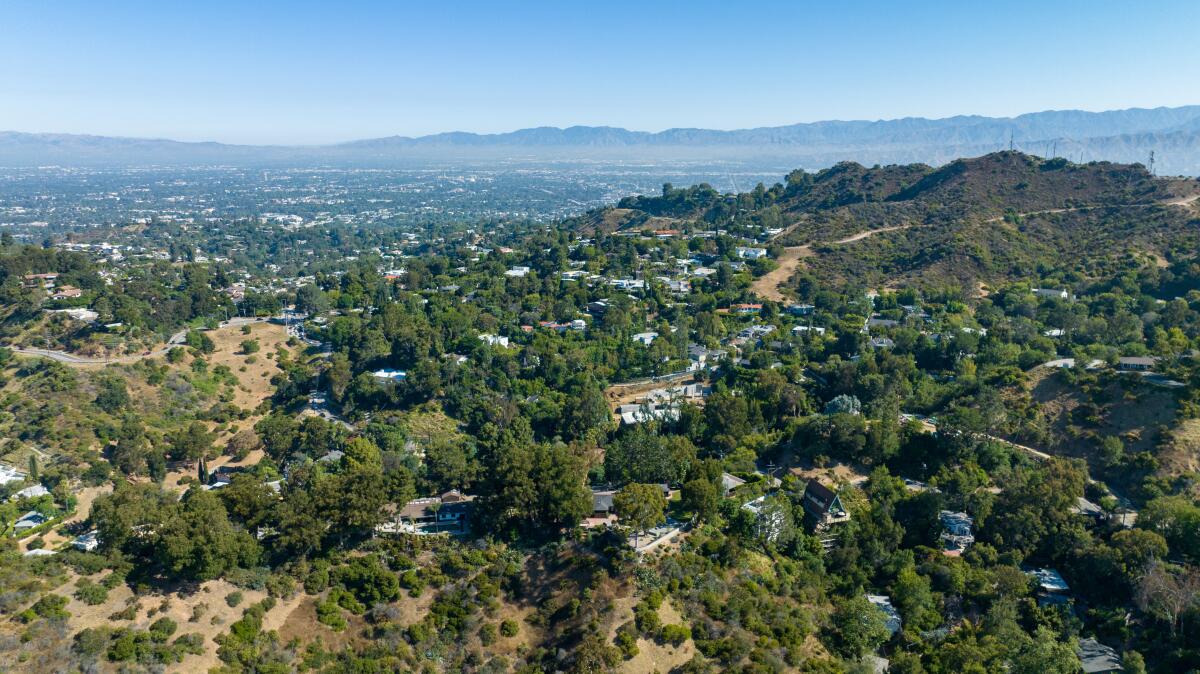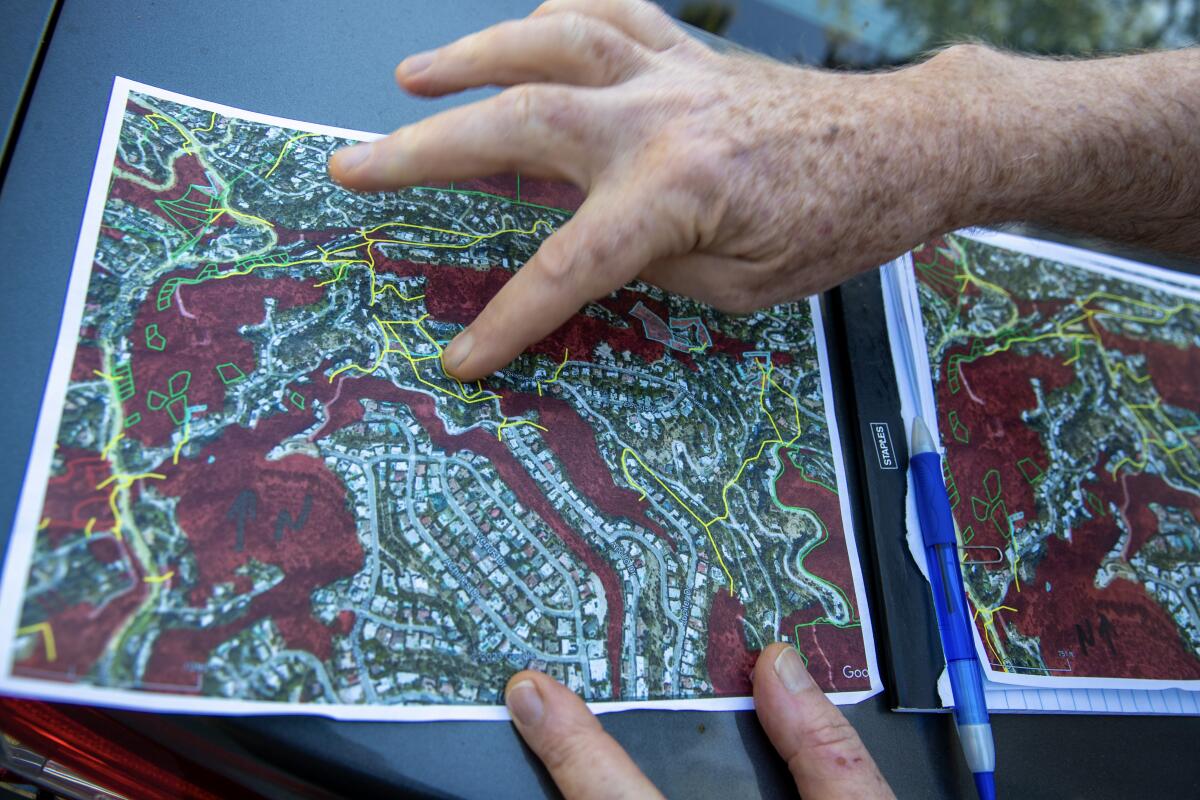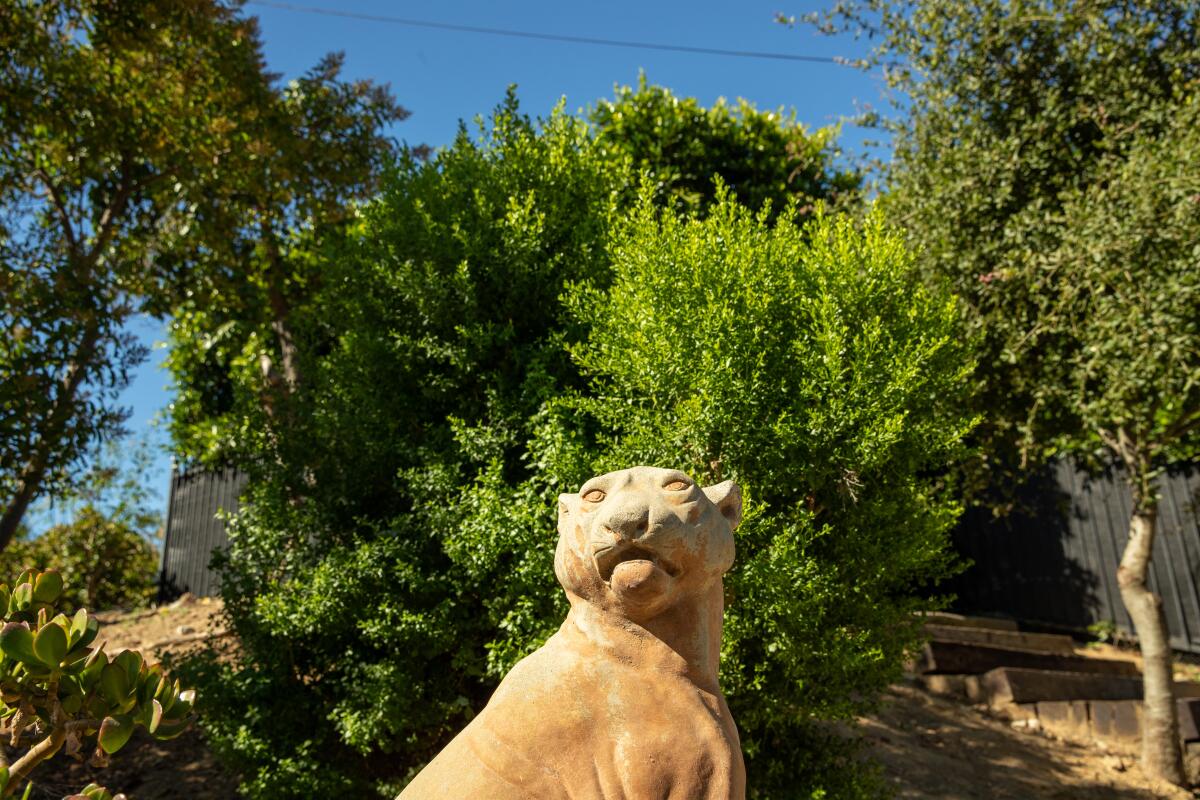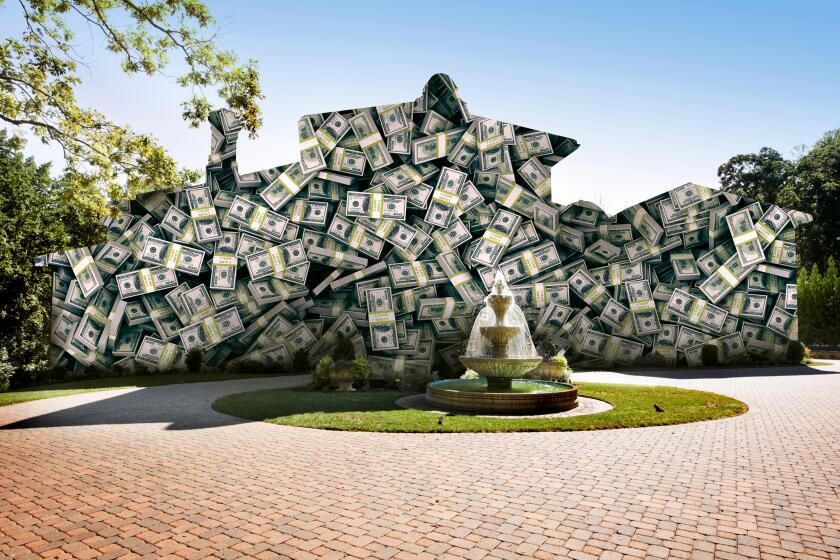L.A. looks to tighten rules for single-family homes in part of Santa Monica Mountains

- Share via
The growth of mega-mansions in Bel-Air and other hillside L.A. neighborhoods sparked new city rules over the last decade aimed at stopping overdevelopment.
Now, the city is poised to crack down again on home-building in the hills, this time in the name of preserving wildlife habitats.
A proposed ordinance targets the Santa Monica Mountains between the 405 and 101 freeways, an iconic area crowded with celebrity compounds, modest ranches, public parks and curving roads.
The rules would make it harder to build mansions and additions, as well as bigger homes on steep hillsides. It would add regulations to limit development near open space, protect soil and trees, and consider the pathways of wildlife, such as deer, bobcats or mountain lions.
Supporters include Councilmembers Nithya Raman and Katy Yaroslavsky, who represent hillside areas; several neighborhood groups and environmental advocates.
Backers cite changing climate, the loss of animal species and the degradation of the hillsides. Wildfires and the recent landslide in Rolling Hills Estates are examples of why the city needs more scrutiny of hillside development, supporters say.
Opponents, who include real estate agents and some homeowners, predict the rules will hurt property values and argue that the hillsides are already built out. Actor and wellness executive Gwyneth Paltrow signed a form letter to the planning department last fall that said the ordinance “burdens homeowners with unnecessary development regulations.”
The ‘wealth defense industry’ — a network of accountants and consultants tasked with helping the rich stay rich — is responsible for homeowners avoiding L.A.’s ‘mansion tax.’
At the same time, some environmental advocates say the final version of the ordinance was watered down. An earlier requirement for wildlife-friendly fencing so deer could move between lots was scrapped, for instance, after homeowners complained about security.
The proposed law — called the wildlife ordinance — would apply to new homes, additions and major remodels. The City Council is poised to pass the ordinance later this year after it cleared a key City Hall committee in June.

Paul Edelman, deputy director of natural resources and planning at the Santa Monica Mountains Conservancy, described the ordinance as a compromise between the competing interests of homeowners, environmentalists and politicians. The conservancy consulted on the law.
It’s significant that wildlife and habitat would be considered by the planning department, Edelman said. “Before, the city had a blind eye to all of this,” he said.
Then-Councilmember Paul Koretz proposed the ordinance in 2014, envisioning rules that would allow a stretch of land on the side of a home for animals to pass.
The number of deer, in particular, has diminished in some hillside areas, pushed out by construction and traffic, according to environmental groups. A video showing L.A. firefighters helping a deer wedged in a fence illustrates the hazards faced by wildlife.
Other recent high-profile wildlife initiatives include a bridge for animals on the 101 Freeway in Agoura Hills and wildlife corridor rules in Ventura County that seek to concentrate development away from the habitat areas.
As Koretz’s ordinance evolved — it is now in its third version — the proposal incorporated other hillside construction elements being debated at the city’s planning department.
Under the proposed law, a new residence that is 6,000 square feet or larger would require additional review by the city’s planning department. Today, homes that are 17,500 square feet or larger require such a review.
Planned development within 25 feet of open space would also need additional review.
The goal is for builders to work with city planners to site their homes, pools and garages in a way that is less harmful to the environment and animals.
The ordinance would also close loopholes in existing hillside construction regulations for single-family homes passed in recent years. It would no longer exempt, for instance, basement space toward the square footage of a property as part of an effort to limit hillside grading. The exemption prompted some homeowners to build massive basements, according to the city.
The proposed ordinance also states that no more than 50% of a lot can be covered by a building or other type of structure. (The law counts tennis courts, pools and patios toward lot coverage.) Exempt are R1- or R2-zoned lots, which are smaller lots with single-family homes or duplexes.

In Laurel Canyon, the noise of machinery scraping the earth could be heard on a recent afternoon near Woodstock Road, where nightclub mogul and film producer Victor Drai is putting up a mansion.
Larger homes are now commonplace: The median new primary structure size in 2020 in the proposed wildlife ordinance area was 8,854 square feet, according to the city.
“We’re getting gigantic homes that displace habitat for wildlife,” said Jamie Hall, president of the Laurel Canyon Land Trust, who supports the ordinance. “There is really no regulation on the books that comprehensibly addresses wildlife and habitat.”
The area targeted for the wildlife ordinance totals about 23,000 acres. About 98% of the land parcels in the area are zoned for low-density residential uses, making up 21,000 acres of residential land, according to the planning department.
Environmentalists failed to win some protections for habitat in the ordinance. They wanted smaller homes — of 3,000 square feet or more — to trigger the planning review. Also, a provision to ban development near rivers, streams, lakes and wetlands was scrapped in the final version.
At a hearing last year on the ordinance, city environmental affairs officer Amanda Amaral urged city planning commissioners to add back in some of the wildlife-friendly provisions.
She told the commissioners that scientists estimate that 1 million species will go extinct in the next few decades.
Get the lowdown on L.A. politics
Sign up for our L.A. City Hall newsletter to get weekly insights, scoops and analysis.
You may occasionally receive promotional content from the Los Angeles Times.
The city’s “biodiversity team believes that the revised ordinance has been diluted from its original draft as a result of the weakened requirements,” Amaral said.
At another hearing, an opponent of the proposal called council members “communists” and accused them of penalizing taxpayers. “Go work in Russia!” he said.
Alison MacCracken, a real estate agent, said the ordinance would hurt the property values of even modest-sized homes. She owns such a home in upper Bel-Air, she said, but the ordinance would limit how big an addition she could add because her lot is on a slope.
“These are very constrictive regulations on top of other development regulations,” MacCracken said.
Attorney Ben Reznik, who represents some opponents, including MacCracken, sent a letter in June to Planning, Land Use and Management Committee Chair Councilmember Marqueece Harris-Dawson and other city representatives that asked for a formal environmental analysis of the wildlife ordinance.
“The reality is, the city has been using wildlife as a mascot for a stricter hillside regulation ordinance, doing so by making it seem as if the ordinance regulates wildlife, when it does not,” Reznik wrote. “This is both misleading to the public, and a clear due process violation.”
Meanwhile, the ordinance is being closely watched in other parts of the city by those who see it as a tool to regulate hillside development.
Elva Yañez, board president of the preservation group Save Elephant Hill on the city’s Eastside, wants the ordinance expanded to all wildlife-rich areas.
“Given where we are at with the climate emergency,” Yañez said, “we should expand these types of policies when we can.”
More to Read
Sign up for Essential California
The most important California stories and recommendations in your inbox every morning.
You may occasionally receive promotional content from the Los Angeles Times.















